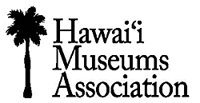The Hawai`i Museum Association (HMA) held its 2013 Annual Meeting on April 5, 2013 in Honolulu. The meeting was hosted at the Queen Emma Summer Palace, and 34 members attended this afternoon event.
We had a lovely location for our meeting. Hānaiakamalama, or Queen Emma Summer Palace, is a historic landmark and museum located on the Pali Highway in Nuuanu Valley. The site was a summer home and retreat for Queen Emma, her husband King Kamehameha IV, and their son Albert. Siding for the Greek Revival structure was cut in Boston and shipped to Hawai`i where it was assembled in 1848 by John Lewis, a part Hawaiian businessman. In 1860, it was sold to Queen Emma’s uncle who willed it to his niece in 1857. Although she lost her son in 1862 and her husband in 1863, Queen Emma maintained this residence from 1857 until her death in 1885. When the Provisional Government of Hawai`i threatened to build a park on the site, the Summer Palace was purchased by the Daughters of Hawaii and preserved as a historic site.
Prior the Annual Meeting, members had the opportunity to take self-guided tours through the Palace before gathering in a stone meeting hall connected to the Palace by a breezeway. The museum houses an assortment of Victorian, fusion, and Hawaiian artifacts and memorabilia that illustrate the close ties of the Hawaiian monarchs to Great Britain, as well as to Hawaiian tradition. The buildings sit on a hill overlooking a valley, and are surrounded by lawns and foliage. Once there, it is easy to understand why the high chiefs and monarchs of Hawai`i preferred to escape Honolulu’s summer heat for this beautiful, breezy location.
Topics covered during the meeting reflected some of the unique circumstances and challenges faced by museums in Hawai`i, as well as issues common to other regional organizations. Members of HMA are spread out among several islands, so cultivating diversity in the organization includes ensuring that not only the various islands are represented, but also the variety of museums and cultural organizations. Current board members come from Maui, Kaua`i, Hawai`i Island, and Oahu. Travel between islands has recently become more expensive with fewer flights per day, so bringing all of our board members or our membership together for meetings is challenging. For the same geographical reasons, upgrading and maximizing the potential of social media was also an important topic of discussion.
We capitalized on our host location by including an interesting talk by local author and historian Barbara Del Piano about the seminal role The Daughters of Hawai`i played in establishing historic preservation in Hawai`i. Originally started as a small social club whose members could all trace their origins to missionary descent, the Daughters grew to include relatives, friends, and Hawaiian elite. With a primary focus on preserving the history of important sites and correct pronunciation of the Hawaiian language, they installed the first historic plaques in the islands. When they assumed control of Queen Emma Summer Palace in 1917, they established the first historic house museum in the Territory of Hawai`i. Today these “pioneers of historic preservation in Hawai`i are now 1300 strong and manage both Queen Emma Summer Palace and Hulihe`e on the Island of Hawai’i, another retreat for Hawaiian monarchs. They also do charity work.
The meeting was adjourned with a reminder from President Jane Hoffman (from Kilauea Lighthouse on Kaua`i) that we will be starting early to plan a mini-conference at our Annual Meeting next year.
Heather Diamond is the curator at `Iolani Palace as well as adjunct faculty at the University of Hawaii where she teaches Museum Studies and other courses. She received her B.F.A. and M.A. at the University of Houston and her Ph.D. in American Studies from the University of Hawai`i. She is a board member of the Hawai`i Museum Association.









Add new comment